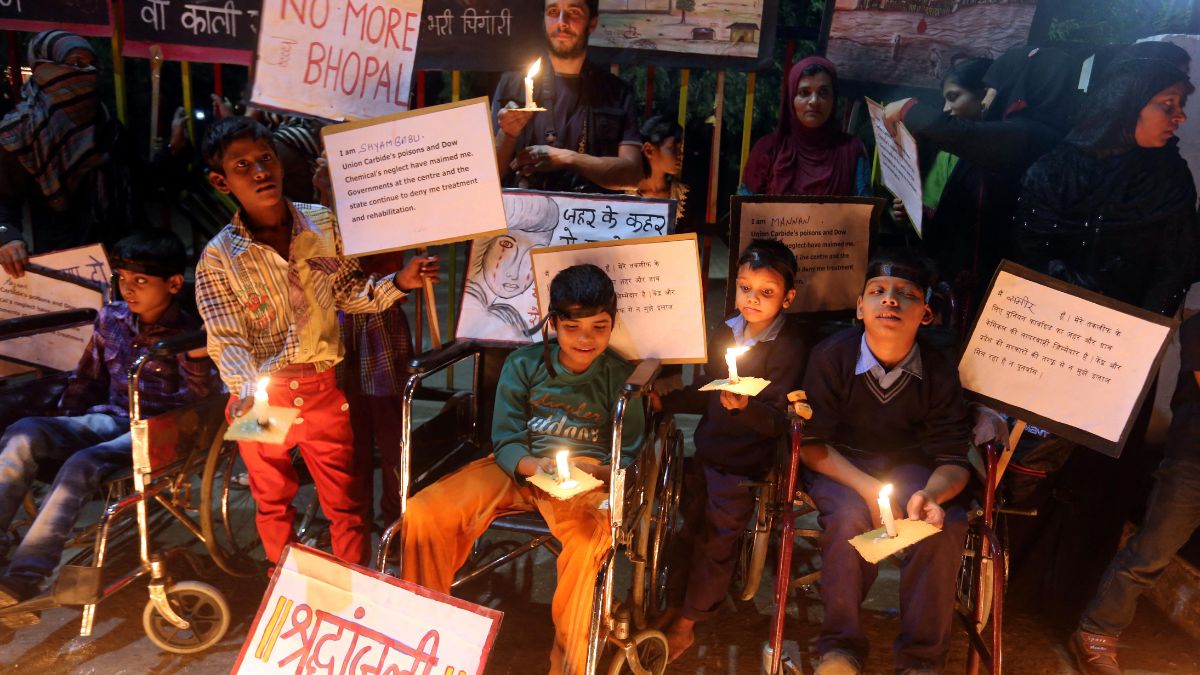It was the intervening night of December 2-3 about 40 years back that India saw the world’s worst industrial disaster. In 1984, highly toxic methyl isocyanate (MIC) leaked from American company Union Carbide’s pesticide factory in Bhopal, exposing around five lakh people to the poisonous gas.
Bhopal gas tragedy, as it has come to be known, was one of the worst humanitarian and environmental disasters in the world. The official number of deaths was 2,259, which remains disputed. An estimated 574,000 people were poisoned in Bhopal as 40 tonnes of toxic methyl isocyanate gas was released into the air.
Over 20,000 people have died since the night of the disaster from related conditions. The accident has impacted not just those who were exposed to the gas but also the babies who were in their mother’s wombs at the time and their later generations.
Let’s take a look.
Bhopal gas tragedy’s victims
Thousands of survivors of the Bhopal industrial disaster have said they and their families are still suffering from chronic health problems.
Those exposed to that gas on that fateful night complained of breathing issues, coughing, and irritation in the eyes and skin.
Over the years, more than 22,000 people died from exposure to methyl isocyanate and more than half a million were maimed for life.
Survivors still face chronic health issues, including cancer, lung and heart diseases and neurological damage.
As per The Guardian’s 2019 report, Sambhavna Trust found the mortality rate for victims exposed to the toxic gas is still 28 per cent higher than average.
The data collected by the Trust from 2010 showed that survivors of the Bhopal gas disaster are twice as likely to die of cancers, lung diseases and tuberculosis. They are more prone to die from kidney diseases and 63 per cent more likely to develop illnesses.
The Trust’s data revealed that women, including even those who were babies at the time of the tragedy, were especially affected leading to high rates of infertility, stillbirths, abortions, early menopause, and disrupting menstrual cycles, The Guardian reported.
How it hurt people who were not even born
Many studies have shown how babies born to survivors of the Bhopal gas disaster have been impacted.
The children of those who inhaled the toxic gas were born with disabilities, including muscular dystrophy, Down’s syndrome, and attention-deficit disorders.
A study published last year traced the intergenerational impact of the Bhopal gas tragedy. It found that men born in Bhopal in 1985 have a higher risk of cancer and increased rates of disabilities as compared to those born before or after 1985, reported NPR.
The research also revealed that the tragedy affected even those who lived about 100 km from the disaster site in Bhopal.
Earlier, an unpublished study, conducted by the Indian Council of Medical Research (ICMR) between January 2016 and June 2017, accessed by four organisations of the Bhopal gas victims showed nine per cent of the 1,048 babies born to mothers who survived the disaster had congenital malformations. In contrast, only 1.3 per cent of the 1,247 babies born to mothers not exposed to the toxic gas had congenital malformations.
A woman survivor of the Bhopal gas leak told the PTI news agency in 2021, “I was eight months pregnant when the gas tragedy happened. My daughter was born with nasal-related complications though not severe.”
Omwati Yadav, who can see the Union Carbide factory from her house’s roof, has two grandsons who were born severely disabled by cerebral palsy and muscular dystrophy. The children’s parents were exposed to the toxic gas, reported The Guardian.
Sajid, who was then a year-and-a-half when the tragedy occurred, passed on the impact to his child decades later. His son suffers from attention deficit hyperactivity disorder (ADHD), as per a PTI report.
Dr DK Satpathy, former head of the forensics department of Bhopal’s Gandhi Medical College, recently said that children born to mothers who survived the tragedy had poisonous substances in their system, which affected the health of the next generation, reported the news agency.
“Not only are we finding high rates of cancers, but also all kinds of immunological issues, neuro skeletal issues, musculoskeletal issues and [a] huge number of birth defects in children being born to gas-exposed parents,” Rachna Dhingra, who works with the International Campaign for Justice in Bhopal, an advocacy organisation, told NPR last year.
The Chingari children’s centre, set up for those born with disabilities due to the disaster, has registered more than 1,000 children, most of whom have cerebral palsy, muscular dystrophy, autism, intellectual disabilities and severe learning problems.
“This is the terrible legacy of Bhopal: all of these children were born to parents, or even grandparents, who were in contact with the gas that night,” Rashida Bee, the centre’s founder, told The Guardian in 2019. “The situation is getting worse, not better. We are seeing more and more second and third generation children being born with such disabilities and coming here. Bhopal’s tragedy has not stopped.”
With input from agencies


)

)
)
)
)
)
)
)
)



